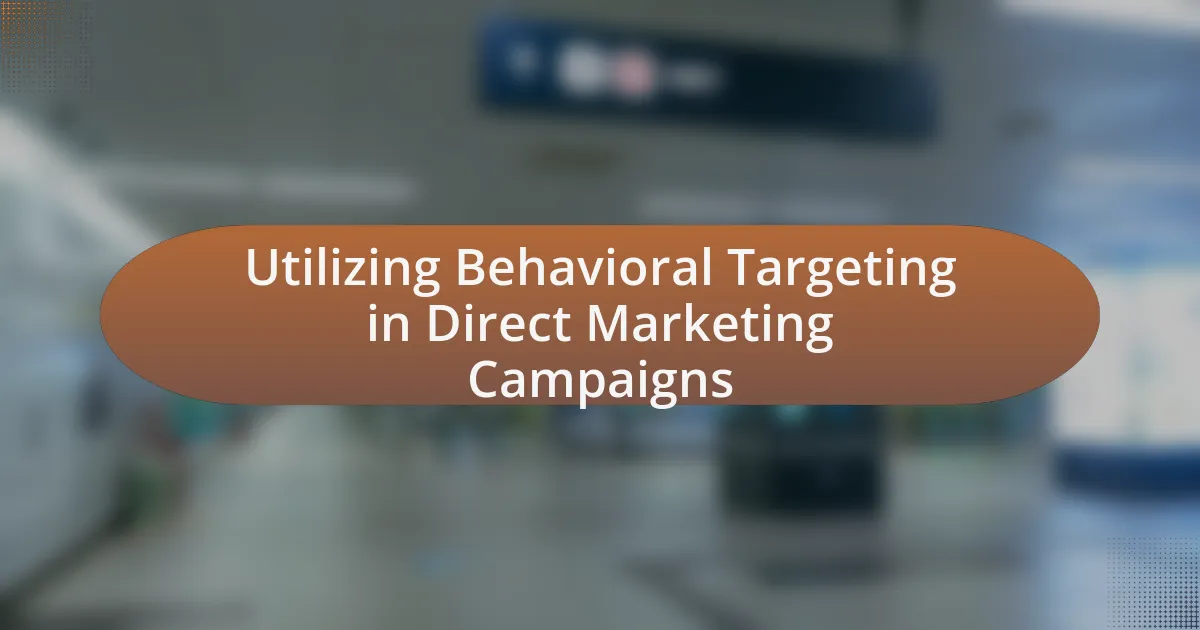A/B testing in email marketing is a critical method for optimizing campaign performance by comparing two versions of an email to identify which one yields better results in terms of open rates, click-through rates, and conversion rates. The article outlines the mechanics of A/B testing, including its key components, the impact of variations in email elements, and the importance of statistical significance. It also discusses best practices for conducting tests, common elements to evaluate, and the challenges marketers face, along with strategies to overcome these obstacles. Additionally, the article highlights recommended tools and platforms for effective A/B testing, emphasizing the significant benefits that data-driven insights can provide for enhancing customer engagement and overall marketing success.
What is A/B Testing in Email Marketing?
A/B testing in email marketing is a method used to compare two versions of an email to determine which one performs better. This technique involves sending one version of the email (Version A) to a segment of the audience and a different version (Version B) to another segment. The performance is measured based on specific metrics such as open rates, click-through rates, and conversion rates. Research indicates that A/B testing can lead to significant improvements in email campaign effectiveness, with studies showing that businesses can increase their conversion rates by up to 49% through systematic testing and optimization.
How does A/B Testing work in the context of email marketing?
A/B testing in email marketing involves comparing two versions of an email to determine which one performs better in achieving specific goals, such as higher open rates or click-through rates. In this process, a sample of the email list is divided into two groups; one group receives version A, while the other receives version B. Metrics such as engagement and conversion rates are then analyzed to identify the more effective version. According to a study by HubSpot, A/B testing can increase email click rates by up to 49%, demonstrating its effectiveness in optimizing email campaigns.
What are the key components of A/B Testing in email campaigns?
The key components of A/B Testing in email campaigns include the hypothesis, control and variant groups, metrics for evaluation, and statistical significance. The hypothesis defines what you aim to test, such as whether a different subject line increases open rates. The control group represents the original version of the email, while the variant group contains the modified version. Metrics for evaluation, such as open rates, click-through rates, and conversion rates, provide measurable outcomes to assess performance. Finally, statistical significance ensures that the results are not due to random chance, often requiring a sample size large enough to yield reliable data.
How do variations in email elements impact A/B Testing results?
Variations in email elements significantly impact A/B Testing results by influencing recipient engagement and conversion rates. For instance, changes in subject lines can lead to different open rates; a study by Mailchimp found that subject lines with personalized content increased open rates by 26%. Additionally, variations in call-to-action buttons can affect click-through rates; research indicates that using contrasting colors for buttons can increase clicks by up to 21%. Therefore, the specific elements tested, such as subject lines, images, and layout, directly correlate with the effectiveness of email campaigns, providing measurable insights into audience preferences and behaviors.
Why is A/B Testing crucial for email marketing success?
A/B testing is crucial for email marketing success because it allows marketers to compare two versions of an email to determine which one performs better in terms of key metrics like open rates and click-through rates. By systematically testing different elements such as subject lines, content, and call-to-action buttons, marketers can make data-driven decisions that enhance engagement and conversion rates. Research indicates that companies using A/B testing in their email campaigns can achieve up to a 49% higher click-through rate, demonstrating its effectiveness in optimizing email performance.
What specific benefits does A/B Testing provide to marketers?
A/B Testing provides marketers with the ability to optimize their campaigns by comparing two versions of a marketing asset to determine which performs better. This method allows marketers to make data-driven decisions, leading to improved conversion rates and higher engagement levels. For instance, a study by Optimizely found that A/B testing can increase conversion rates by up to 49%. Additionally, A/B Testing helps in understanding customer preferences, enabling marketers to tailor their strategies effectively, which can result in enhanced customer satisfaction and loyalty.
How does A/B Testing influence customer engagement and conversion rates?
A/B testing significantly enhances customer engagement and conversion rates by allowing marketers to compare two versions of an email to determine which one performs better. This method provides data-driven insights that help identify the most effective elements, such as subject lines, content, and call-to-action buttons. For instance, a study by Optimizely found that A/B testing can lead to conversion rate improvements of up to 49%. By optimizing these elements based on real user interactions, businesses can tailor their messaging to better resonate with their audience, ultimately driving higher engagement and increased sales.
What are the best practices for conducting A/B Testing in email marketing?
The best practices for conducting A/B testing in email marketing include defining clear objectives, segmenting your audience, testing one variable at a time, and analyzing results thoroughly. Defining clear objectives ensures that the test focuses on specific outcomes, such as open rates or click-through rates. Segmenting your audience allows for more targeted insights, as different groups may respond differently to variations. Testing one variable at a time, such as subject lines or call-to-action buttons, isolates the impact of that change, making it easier to draw conclusions. Analyzing results thoroughly involves using statistical significance to determine whether the observed differences are meaningful, which can be supported by tools like Google Analytics or email marketing platforms that provide A/B testing features.
How should marketers choose what to test in their email campaigns?
Marketers should choose what to test in their email campaigns by prioritizing elements that directly impact engagement and conversion rates. Key areas to focus on include subject lines, call-to-action buttons, email layouts, and personalization strategies. For instance, a study by Campaign Monitor found that personalized emails can deliver six times higher transaction rates compared to non-personalized ones. By systematically testing these components, marketers can gather data-driven insights that inform future strategies and optimize overall campaign performance.
What common elements can be tested in email marketing?
Common elements that can be tested in email marketing include subject lines, email content, call-to-action buttons, send times, and audience segmentation. Testing subject lines can reveal which phrases generate higher open rates; for instance, a study by Mailchimp found that personalized subject lines can increase open rates by 26%. Email content variations, such as text versus images, can affect engagement levels, with research indicating that emails with images can boost click-through rates by 42%. The placement and wording of call-to-action buttons can significantly influence conversion rates, as shown by a HubSpot analysis that found changing the color of a button increased clicks by 21%. Additionally, testing different send times can optimize engagement, with studies suggesting that emails sent on Tuesdays and Thursdays tend to perform better. Finally, audience segmentation allows marketers to tailor messages to specific groups, enhancing relevance and effectiveness, as evidenced by a report from Campaign Monitor that states segmented campaigns can lead to a 760% increase in revenue.
How can marketers prioritize tests for maximum impact?
Marketers can prioritize tests for maximum impact by focusing on high-traffic segments and key performance indicators (KPIs) that directly influence conversion rates. By analyzing historical data, marketers can identify which elements, such as subject lines or call-to-action buttons, have previously driven engagement. For instance, a study by HubSpot found that A/B testing subject lines can increase open rates by up to 30%. This data-driven approach allows marketers to allocate resources effectively, ensuring that tests are conducted on the most impactful elements, ultimately leading to improved campaign performance.
What metrics should be analyzed during A/B Testing?
The metrics that should be analyzed during A/B Testing include conversion rate, click-through rate, bounce rate, and engagement metrics. Conversion rate measures the percentage of users who complete a desired action, indicating the effectiveness of the tested variation. Click-through rate assesses how many recipients clicked on a link within the email, providing insight into the appeal of the content or call-to-action. Bounce rate reflects the percentage of emails that were not delivered, which can affect overall campaign performance. Engagement metrics, such as time spent on the page or social shares, further evaluate user interaction with the content. Analyzing these metrics allows marketers to make data-driven decisions to optimize email campaigns effectively.
Which key performance indicators (KPIs) are most relevant for email A/B Testing?
The most relevant key performance indicators (KPIs) for email A/B testing include open rates, click-through rates (CTR), conversion rates, bounce rates, and unsubscribe rates. Open rates measure the percentage of recipients who open the email, indicating the effectiveness of the subject line and sender name. Click-through rates assess the percentage of recipients who click on links within the email, reflecting engagement and content relevance. Conversion rates track the percentage of recipients who complete a desired action, such as making a purchase, showcasing the overall effectiveness of the email campaign. Bounce rates indicate the percentage of emails that were not delivered, which can affect overall campaign performance. Unsubscribe rates measure the percentage of recipients who opt out of future emails, providing insight into audience satisfaction and content alignment. These KPIs collectively help marketers evaluate and optimize their email campaigns for better performance.
How can data from A/B Testing be effectively interpreted?
Data from A/B Testing can be effectively interpreted by analyzing key performance indicators (KPIs) such as open rates, click-through rates, and conversion rates. These metrics provide quantitative insights into how different variations of an email perform against each other. For instance, if one email subject line results in a 20% higher open rate compared to another, it indicates a stronger appeal to the audience. Additionally, statistical significance should be assessed using methods like the p-value to ensure that observed differences are not due to random chance. This approach allows marketers to make data-driven decisions that enhance email marketing effectiveness.
What challenges do marketers face with A/B Testing in email marketing?
Marketers face several challenges with A/B testing in email marketing, including sample size limitations, statistical significance, and time constraints. Small sample sizes can lead to inconclusive results, making it difficult to determine which variation performs better. Additionally, achieving statistical significance is crucial; without it, marketers may make decisions based on random chance rather than actual performance differences. Time constraints also pose a challenge, as marketers often need to implement changes quickly, which can limit the duration of tests and affect the reliability of the results. These challenges can hinder the effectiveness of A/B testing and impact overall marketing strategies.
How can marketers overcome common obstacles in A/B Testing?
Marketers can overcome common obstacles in A/B testing by implementing a structured approach that includes clear hypothesis formulation, proper sample size determination, and consistent testing conditions. Establishing a clear hypothesis allows marketers to focus on specific variables, ensuring that tests are relevant and actionable. Proper sample size determination is crucial, as it minimizes the risk of statistical errors; for instance, a sample size calculator can help marketers achieve statistically significant results. Maintaining consistent testing conditions, such as timing and audience segmentation, prevents external factors from skewing results, thereby enhancing the reliability of the findings. These strategies collectively improve the effectiveness of A/B testing in email marketing campaigns.
What are the pitfalls to avoid when conducting A/B Tests?
When conducting A/B tests, it is crucial to avoid several key pitfalls to ensure valid results. One major pitfall is testing too many variables simultaneously, which can lead to confounding results and make it difficult to determine which change influenced the outcome. Additionally, insufficient sample size can result in unreliable data; a study by Optimizely indicates that a sample size that is too small can lead to statistical significance that is not meaningful. Another common mistake is running tests for an inadequate duration, which may not capture variations in user behavior over time. Furthermore, failing to define clear success metrics before starting the test can lead to ambiguous conclusions. Lastly, not segmenting the audience appropriately can skew results, as different user groups may respond differently to changes.
How can marketers ensure statistical significance in their tests?
Marketers can ensure statistical significance in their tests by using an adequate sample size and appropriate statistical methods. A larger sample size reduces the margin of error and increases the likelihood that the results reflect the true effect of the changes being tested. For instance, a sample size calculator can help determine the necessary number of participants based on the expected effect size and desired confidence level. Additionally, employing statistical tests such as t-tests or chi-square tests allows marketers to analyze the data accurately and determine if the observed differences are statistically significant. According to a study published in the Journal of Marketing Research, using a sample size that meets the power analysis requirements significantly enhances the reliability of A/B test results.
What tools and resources are available for A/B Testing in email marketing?
Several tools and resources are available for A/B testing in email marketing, including platforms like Mailchimp, Optimizely, and HubSpot. Mailchimp offers built-in A/B testing features that allow users to test different subject lines, content, and send times to optimize engagement. Optimizely provides a comprehensive suite for A/B testing across various digital channels, including email, enabling marketers to analyze user behavior and improve conversion rates. HubSpot also includes A/B testing capabilities within its email marketing tools, allowing users to experiment with different email elements and track performance metrics. These tools are widely recognized for their effectiveness in enhancing email marketing strategies through data-driven insights.
Which A/B Testing platforms are most recommended for email campaigns?
The most recommended A/B testing platforms for email campaigns are Mailchimp, Optimizely, and HubSpot. Mailchimp offers user-friendly A/B testing features that allow marketers to test subject lines, content, and send times, which can significantly enhance open and click-through rates. Optimizely provides advanced testing capabilities, including multivariate testing, which helps in optimizing various elements of email campaigns for better performance. HubSpot integrates A/B testing seamlessly within its email marketing tools, enabling users to analyze results and make data-driven decisions effectively. These platforms are widely recognized for their effectiveness in improving email marketing outcomes through systematic testing and analysis.
How can marketers leverage analytics tools to enhance A/B Testing?
Marketers can leverage analytics tools to enhance A/B testing by utilizing data-driven insights to optimize campaign performance. These tools provide detailed metrics on user engagement, conversion rates, and behavior patterns, allowing marketers to identify which variations of their email content resonate best with their audience. For instance, platforms like Google Analytics and HubSpot offer features that track user interactions and segment audiences based on their responses, enabling precise adjustments to email strategies. According to a study by Optimizely, businesses that implement A/B testing can see conversion rate improvements of up to 49%, demonstrating the effectiveness of using analytics tools to inform testing decisions.
What are some practical tips for effective A/B Testing in email marketing?
To conduct effective A/B testing in email marketing, marketers should focus on testing one variable at a time, such as subject lines, content layout, or call-to-action buttons. This approach allows for clear identification of which specific change impacts performance metrics like open rates or click-through rates. According to a study by Campaign Monitor, emails with personalized subject lines can increase open rates by 26%, demonstrating the significance of targeted testing. Additionally, segmenting the audience ensures that the test results are relevant and applicable to specific groups, enhancing the overall effectiveness of the email campaign.

















